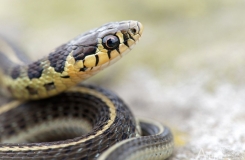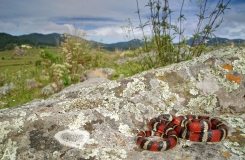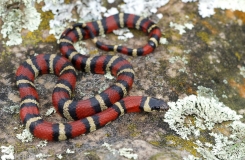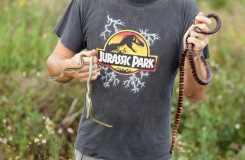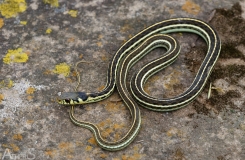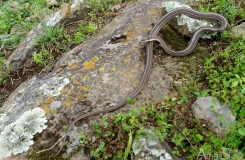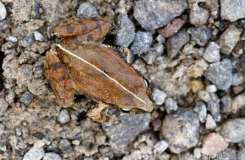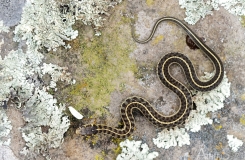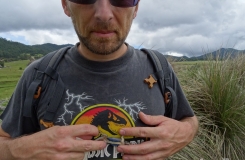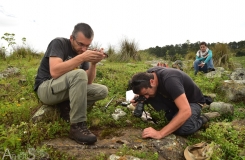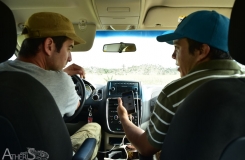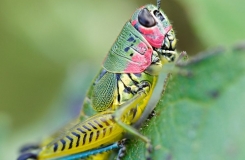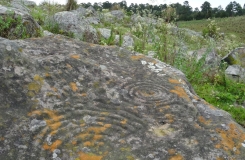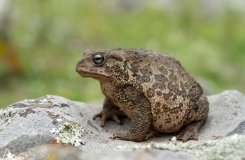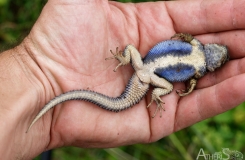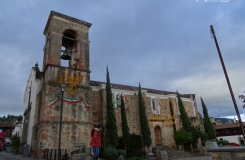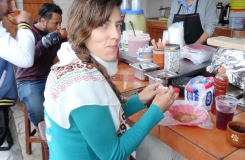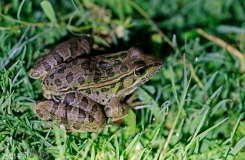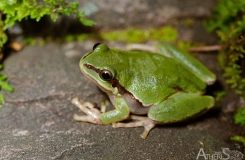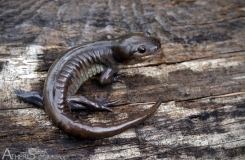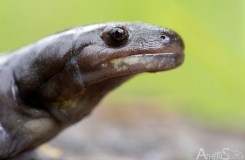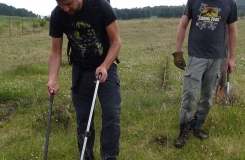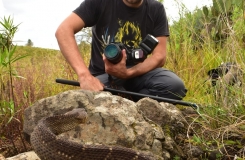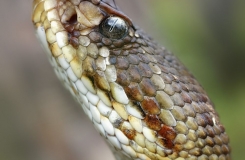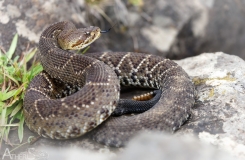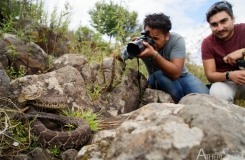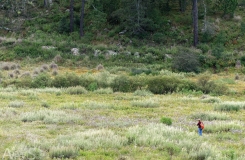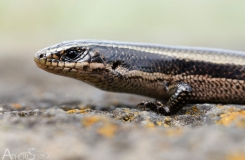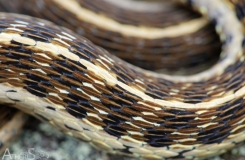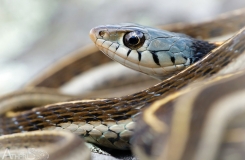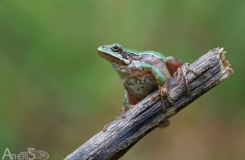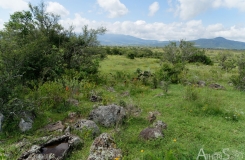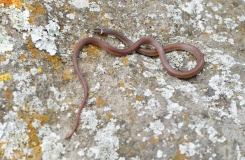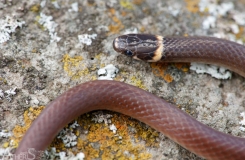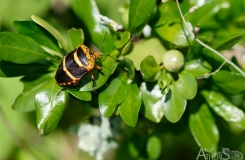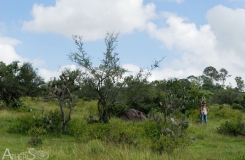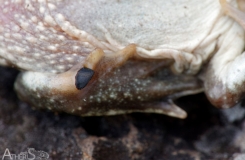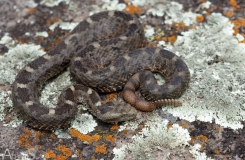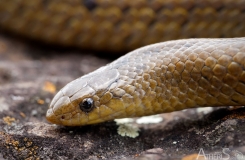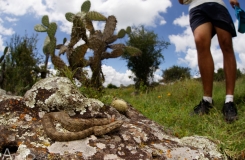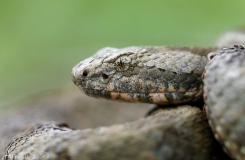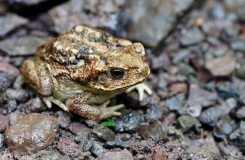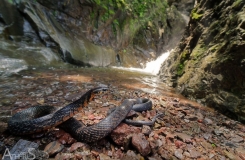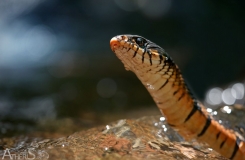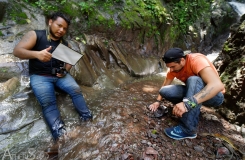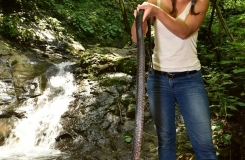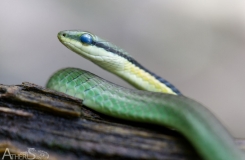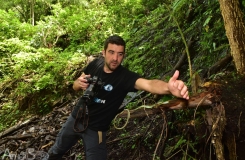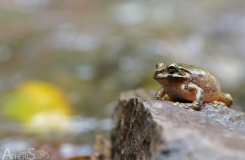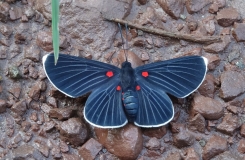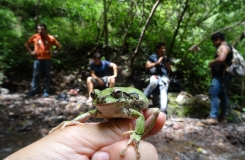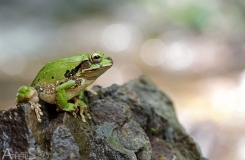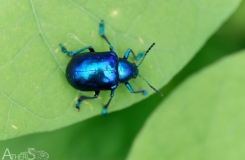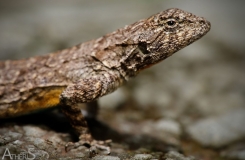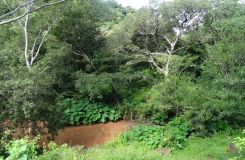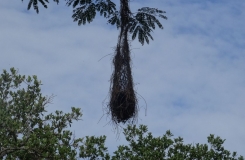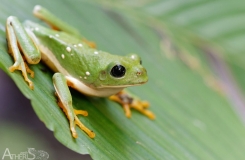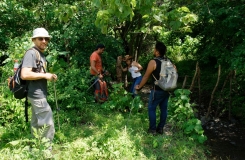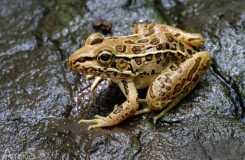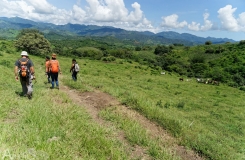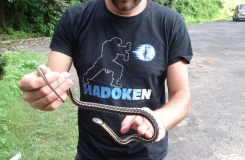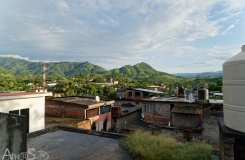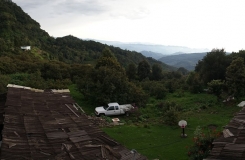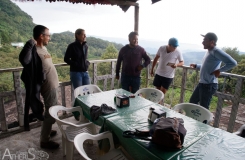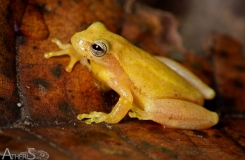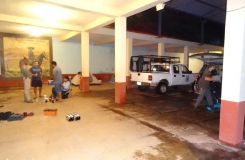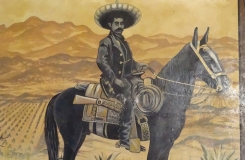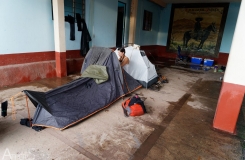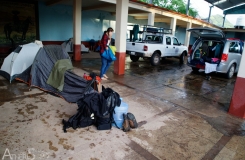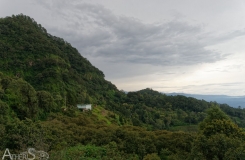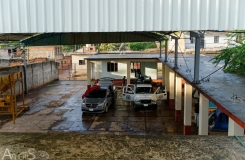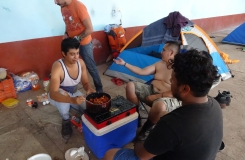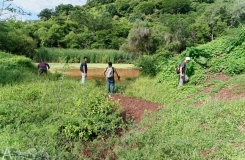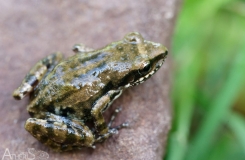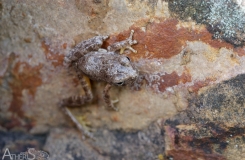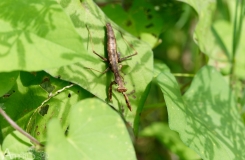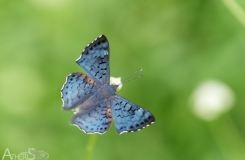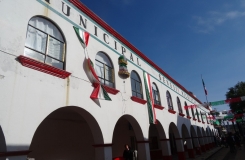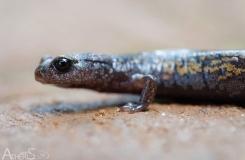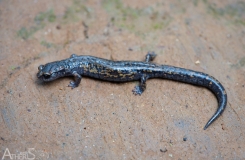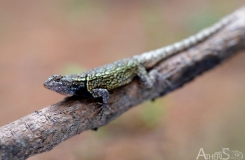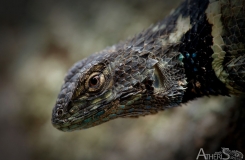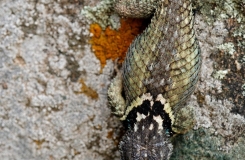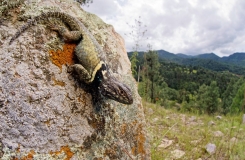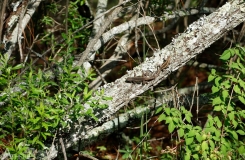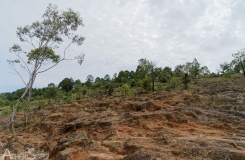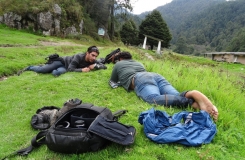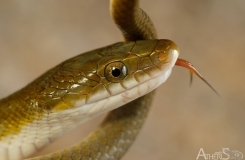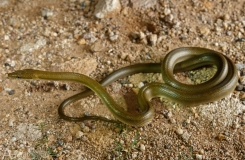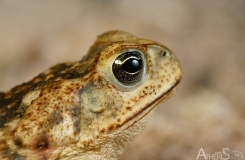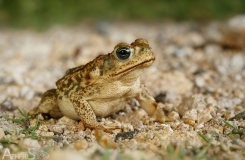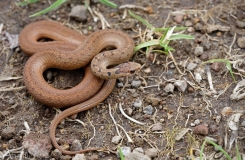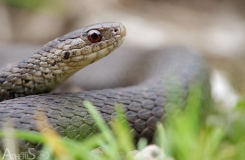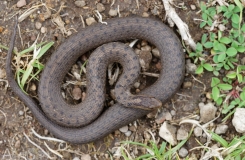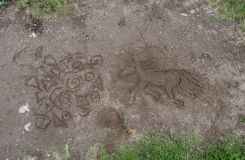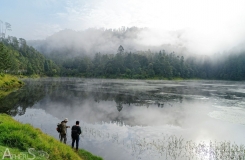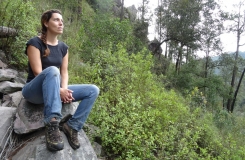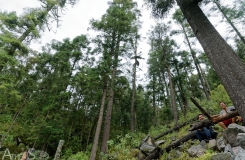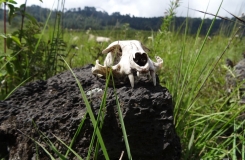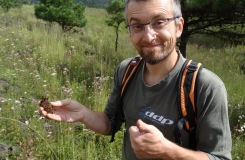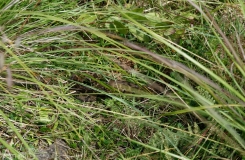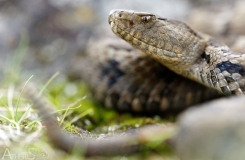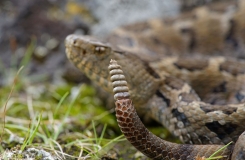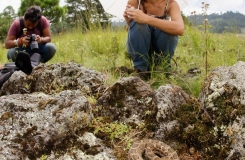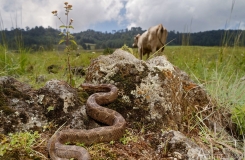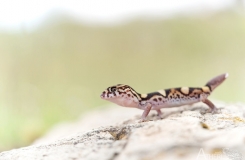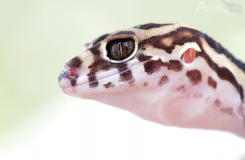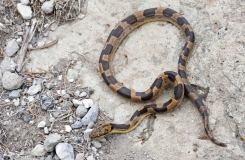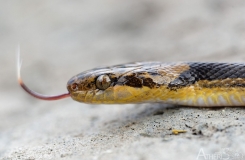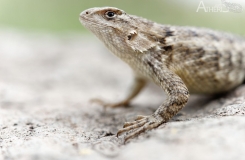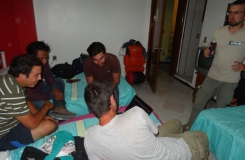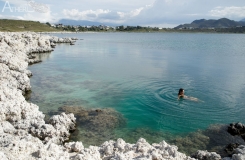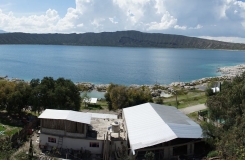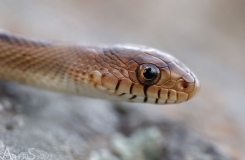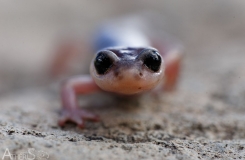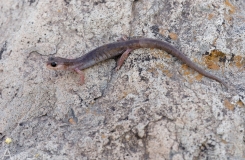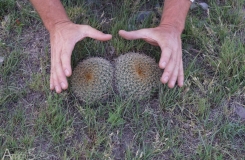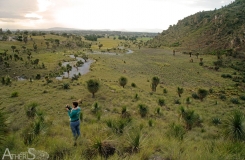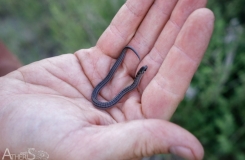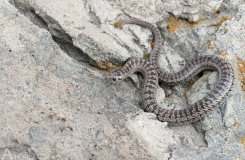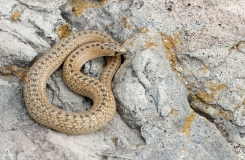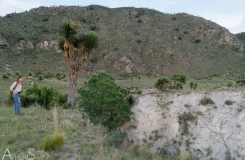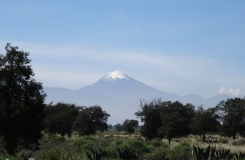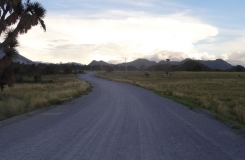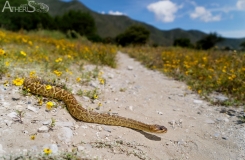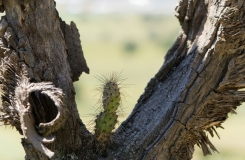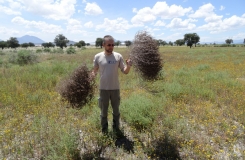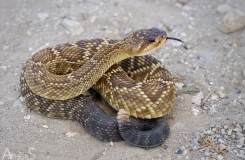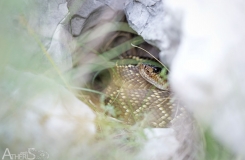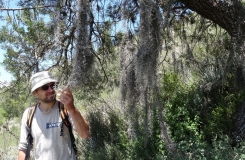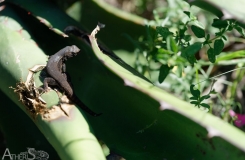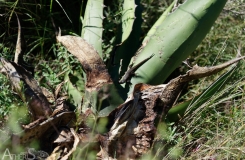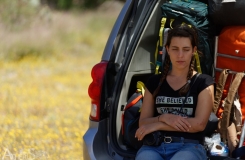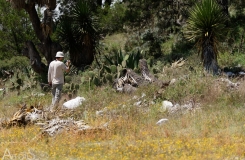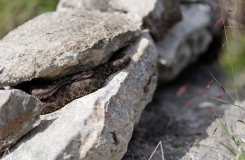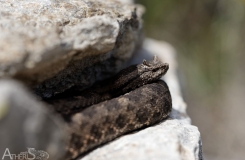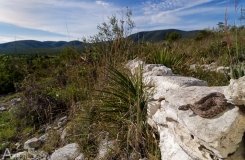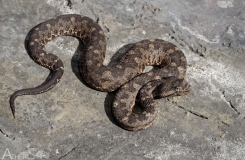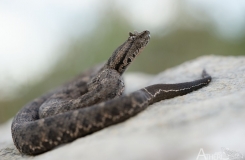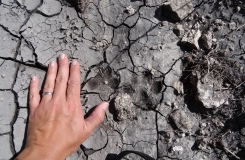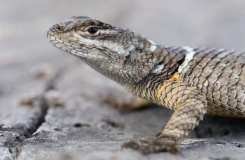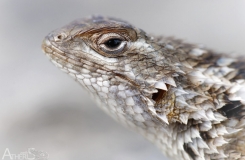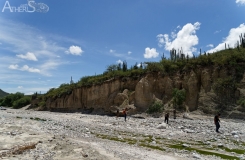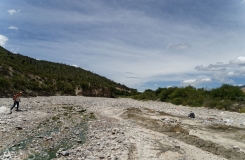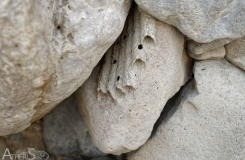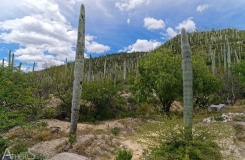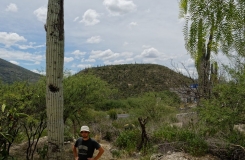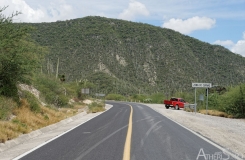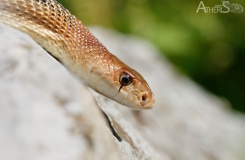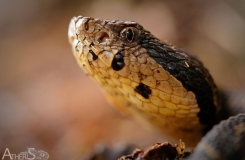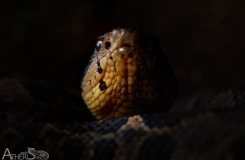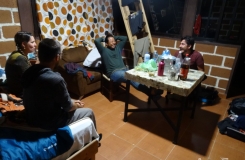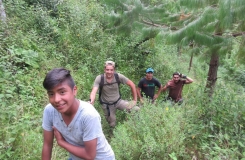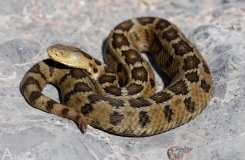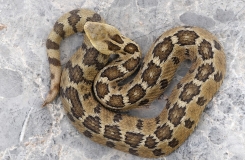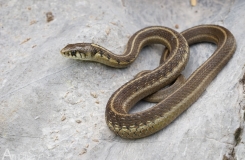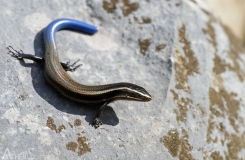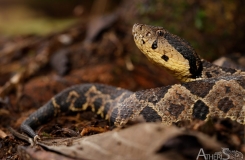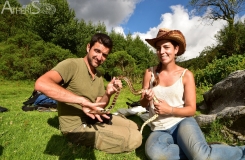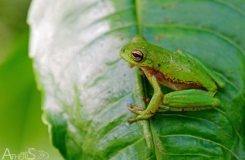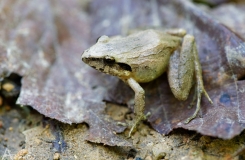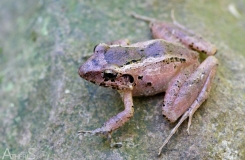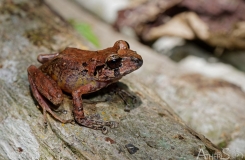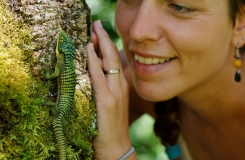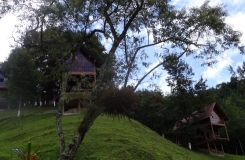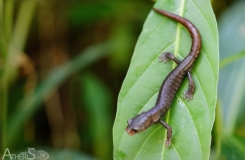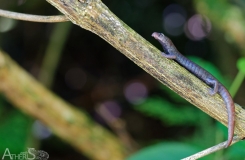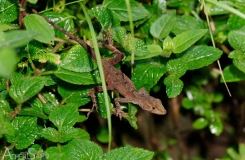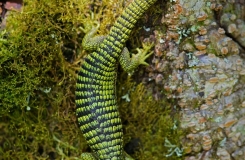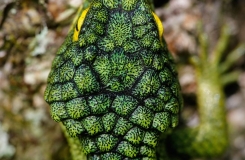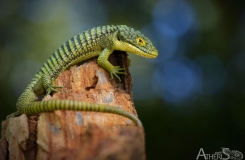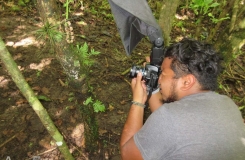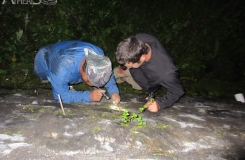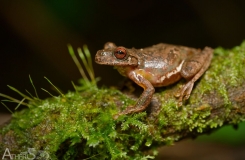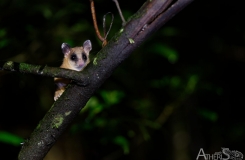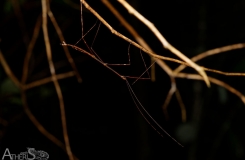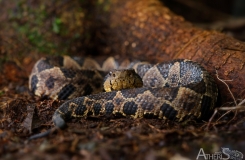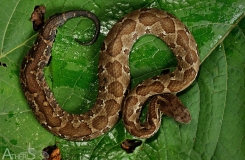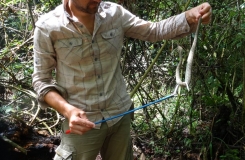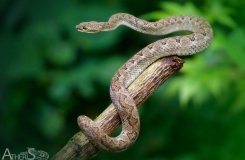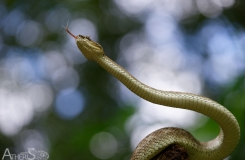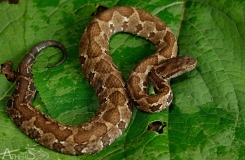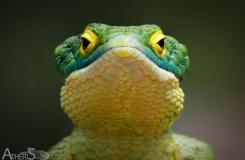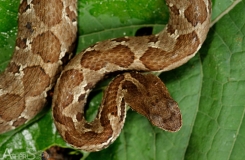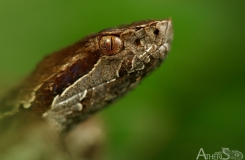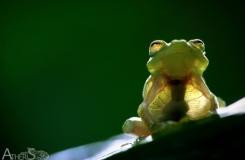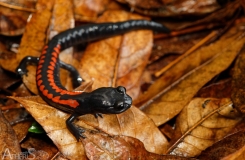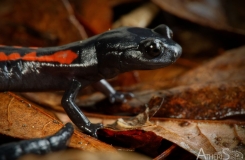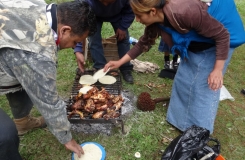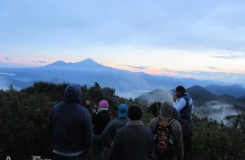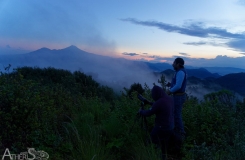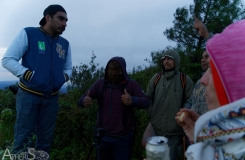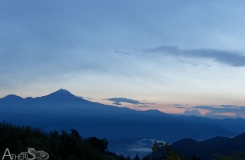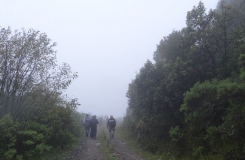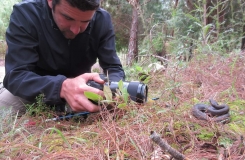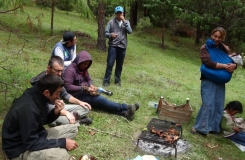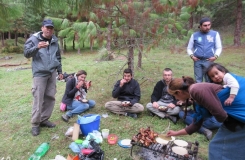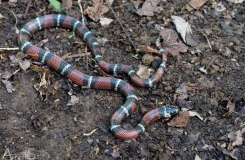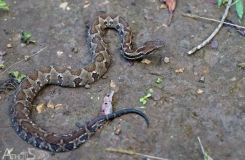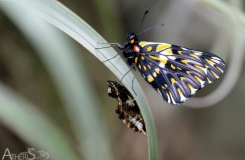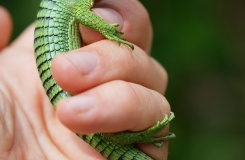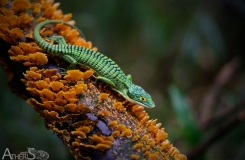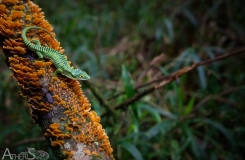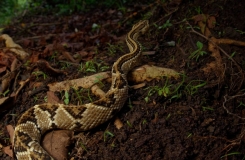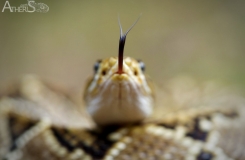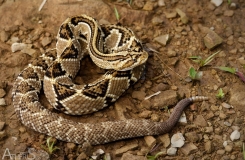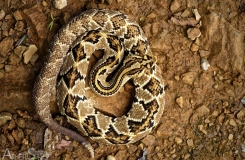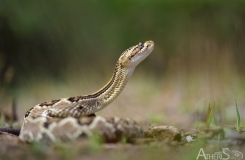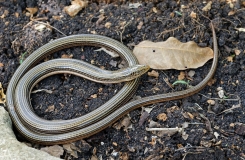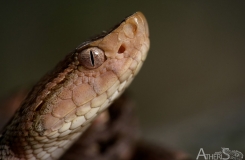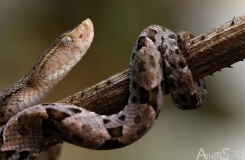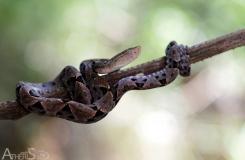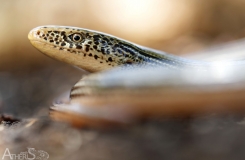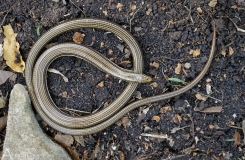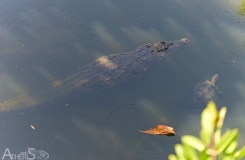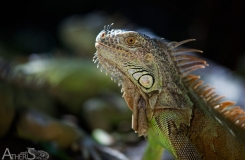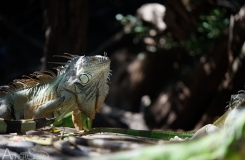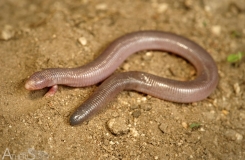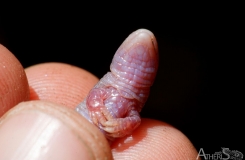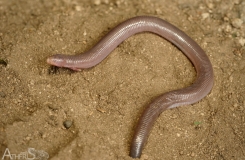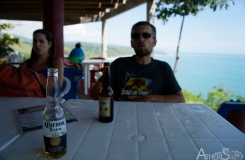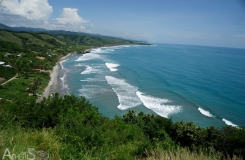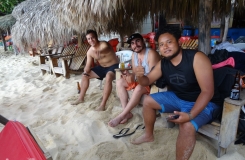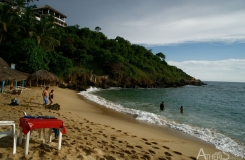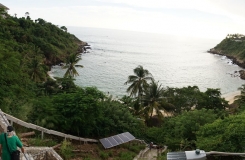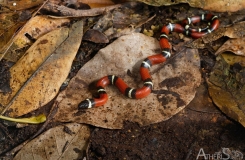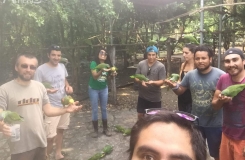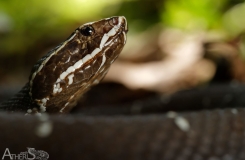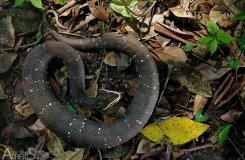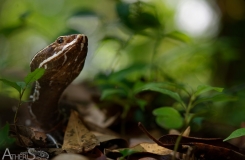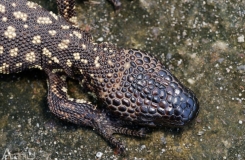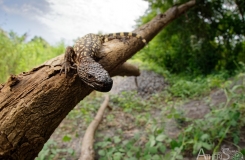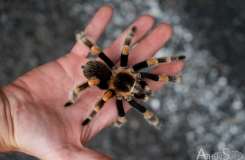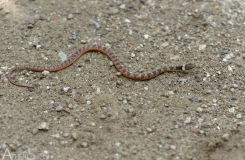Mexico is the paradise of Reptiles. It is the country where live the most reptiles species in the world. Sooner or later, Atheris had to come here! It’s finally a team of three people, Maud, Fabrice et Matthieu which land in Mexico City then Guadalajara… Here expect us three Mexican naturalists, Juan, Ulises and Hector. Let’s go for three weeks of adventure!

JALISCO
We come to this sector to search mainly Crotalus polysticus. This rattlesnake is apparently abundant in rip raps. But despite our repeated research, nothing, no rattlesnake out. Nevertheless, the observations are not lacking: Thamnophis pulchrilatus, Thamnophis scaliger, Thamnophis cyrtopsis, Salvadora bairdi, Lampropeltis ruthveni.
At night, we go in search of some salamanders, more precisely Ambystoma ordinarium. Despite fairly low temperatures and regular rain, we make some observations … but not Ambystoma. Just before go back, a man calls us. Salamanders, he has plenty in his garage! He invites us gently home, where we will discover three Ambystomas, nice! We go to bed, on the road, a lynx crosses the car…
The next day, we try again to find Crotalys polysticus, but again, they do not want to show themselves. But, instead, we find a big female of Crotalus basiliscus. Our first rattlesnake, and a huge one! A great moment.
We then leave further east, still in the mountains, mainly to search for a new species of rattlesnake, Crotalus aquilus. This small rattlesnake is endemic to central Mexico. It rained for several days, and this morning, after a great breakfast, a light sun announces a beautiful day… And indeed, in 5 minutes, we find three rattlesnakes, taking sun, all in the same bush! ! Then nothing … Anyway, some amphibians, including Spea multiplicata, (looks like a Western Spadefoot Pelobates cultripes in France), and some reptiles, of course Sceleporus, or Conopsis nasus and Tantilla bocourti.
MORELIA
Still further east, we reach Morelia, the region of Juan and Ulyses. We go down a little altitude, the landscape changes and the fauna too: we enter here in a tropical context. On site, we are waiting by some young biologists, for two crazy days of prospecting. From the first night, we will find lot of things. Some reptiles, many amphibians… Of course because rain falls hard … more and more strong elsewhere! The rain turns into a flood, a storm, thunder breaks out on our heads… Wow! We had planned to camp on site, but there is 10cm of water on the ground … So we all go back to town, and are warmly invited to take shelter in the building that serves as housing for students. Now we have to dry everything, meanwhile, biologists identify and take measures on amphibians that they will release the next day…
We go back in mountain, in Senguio hoping to observe some new altitude species. It’s national day party, and we’re finally going to spend more time celebrating than looking for reptiles! What a party ! The area of Morelia has been rich in emotion … It will remain in our memories!
CUERNAVACA
We continue east again and we avoid Mexico City from the south. We stop in Cuernavaca and explore the very high altitude areas. We are sometimes close to 3000m, the temperature sometimes drops below 15°C … The landscapes are incredible and remind what we can see here in the French Pyrenees. Here, our main target is Crotalus transversus. It is the rarest rattlesnake in Mexico. It is known that only two sites, 30 observations, no more, would have been made … In short, it seems difficult to find one! This little rattlesnake looks like a smooth snake Coronella austriaca. For sure, evolutionary convergence is here. The day seems favorable to the observation of the species: it is rather cold and cloudy in the early morning, but the sun is gradually gaining and the ground is warming up. However, despite several hours of prospecting, nothing makes it, Crotalus transversus does not want to go out! Too bad, we change places for other species, Thamnophis scalaris and Storeria storerioides. At night, we go in roadcruising down the mountain a few kilometers from here, and watch Senticollis triaspis or Coleonyx elegans.
We then leave for the east coast of the country. On the road, however, we take time to search Crotalus ravus. On a first spot, the species seems abundant, and we quickly observe several specimens. A small rattlesnake, but beautiful, and especially very nervous!
PUEBLA
We are in the north-east half of the country, now in the Puebla region, and again, the landscape changes! A landscape very similar to what we thought of Mexico: the soil is dry and rocky, cactus are numerous, weather is hot. We will stop here several times looking for several species of rattlesnake. Animals must be search under the stones, under cactus, in cactus … It is the paradise! During our surveys, we will observe many species of reptiles, including some rattlesnakes: Crotalus (scutulatus) salvini, Crotalus ravus, and a large Crotalus molossus oaxacus. What a beauty!
The region is rich in volcanoes and craters transformed today into lakes (Popocatépetl and Iztaccihualt for example). Today, some of them are home to Ambystomas, sometimes endemic to a single lake, and only present in pedomorphic form, several tens of meters deep! We can not resist to a small dive, but to observe these species is very illusory …
We then leave in search of one of the most incredible reptiles of Mexico: Mixcoatlus melanurus. This small horned viper, endemic to Mexico, lives on some rocky slopes of the mountains of the region, in a very small area. Prospecting is difficult, and we look for many hours before, miracle, to find a specimen. Magnificent ! What memory !
VERACRUZ
We then go to settle for several days in the mountains of Veracruz, at Finca Santa Martha, at Miguel Angel De La Torre Loranca home. Miguel is a renowned biologist who takes advantage of the incredible geographical and climatic situation of his property to improve the knowledge of Amphibians and Reptiles of the region. Miguel has already described several species, and a snake, Geophis lorancai, found here, in the finca, even bears his name ! Locals often bring back snakes that he can then release to safer locations. The opportunity for us to observe new species difficult to contact elsewhere! Since the Finca, we leave, each day, to different sites, in varied landscapes, in search of particular species. The first day, we look in areas near the Finca: cloud forest, ie high altitude, but still high temperature and high humidity. Exist here two of the most remarkable reptiles of Mexico, the Alligator-lizard Abronia graminea and the mid-arboreal viperid Ophryacus undulatus.
After a first day of research rich in discovery (Crotalus ravus again), Miguel and his friends invite us to an improvised meal: a fire, in the middle of nature, some ears of corn, and the meal is ready!
The next day, we leave early (very early, 3:30!), To join other friends of Miguel. The idea is simple: to reach the summit of a mountain (more than 3000 m anyway!) for a sunrise in first class. This site is also home to two new rattlesnake species: Crotalus triseriatus et Crotalus intermedius. The research starts in the middle of the morning, but the wind, too powerful, and the clouds, too present, reduce our chances of seeing the animals. We return after an unforgettable picnic in the mountains. In the evening, we make a last little night trip that allows us to observe some new and very interesting species: Imantodes cenchoa, Hyalinobatrachium fleischmanni, Atropoides nummifer, Ishumara gigantea…
The next day’s exit is in lowland, towards Veracruz … Very warm weather! We are here to target a very particular lizard: Ophiosaurus ceroni which we will spot near a small village. This species look like a small Pseudopus apodus. It is very rare in Mexico!
ACAPULCO
We leave, sadly, the paradise of the Miguel’s Finca. It is time to start the return to Guadalajara, and the road is long! We choose to return by the Pacific coast and its incredible beaches.
Here again, according to breaks and stops, we will observe some new species. One of them is little known, but it is one of the most strange species of reptiles on the planet. The genus Bipes contains only three species, all endemic to Mexico. Each of them has an extremely small distribution, making them highly endangered species. We will find one of them in the Guerrero district: Bipes tridactylus whose distribution extends over probably less than a hundred km². The observation of some individuals, in a village, in the garden of individuals, will be another great memory of the trip!
The next day, we take several breaks by the sea. The opportunity to observe including some sea turtles (Chelonia mydas probably) and some crocodiles, Crocodilus acutus.
COLIMA
We have gradually moved closer to the airport, and our last stop will be in Colima, about an hour from Guadalajara. Here we find some herpetologists, especially Carlos, Stefania et Jacobo, for a successfull roadcruising night.
Jacobo offers us his accommodation for the night. Amazing! The last mexican night has been musical, a small and cool party. The next day, Carlos invites us to visit the shelter where he works. We take advantage of the place to photograph some Heloderma horridum (what an incredible lizard, but a bit bitten), and a superb specimen of Agkistrodon bilineata freshly saved by the police environment.
It’s time to return to Guadalajara … We finally say goodbye to our friends Juan, Ulises, Hector, and it’s with great memories that we’re waiting for our plane at the airport. During the change of flight, in Mexico, we find Jacobo, who takes the same plane as us! The opportunity for a last cerbeza and big laugh!


CONCLUSION
Mexico has not derogated from its reputation: it is the paradise of reptiles. The diversity is incredible, with a staggering rate of endemism, exacerbated by extremely varied landscapes and climatic conditions.
The animal densities observed were, however, often lower than expected. The season (autumn) during which the trip took place there is certainly no stranger … But we could not really do otherwise this time.
Finally, a big congratulations to the Mexicans for their smiles, their welcome … It was great. One thing however … stop with the « TOPE » !!
Many thanks to Juan, Ulises, Hector, Miguel, Carlos, Stefania, Jacobo and all their friends… which I have not always kept the names … but that we will always remember!
Pictures: Matthieu, Maud, Fabrice, Juan, Ulises, Hector, Miguel
Videos: Maud, Matthieu
Text: Matthieu
Approximative list :
Amphibia
Ambystoma ordinarium
Isthmura gigantea
Pseudoeurycea cafeteria
Pseudoeurycea melanomolga
Pseudourycea leprosa (o cephalica ?)
Pseudoeurycea longicauda
Agalychnis dacnicolor
Craugastor loki
Craugastor lmexicanus
Craugastor occidentalis
Craugastor spatulatus
Dryophites arenicolor
Ecnomiohyla tympano
Eleutherodactylus nitidus
Hyalinobatrachium fleischmanni
Hyla eximia
Hyla plicatus
Incilius marmoreus
Incilius perplexus ?
Incilius occidentalis
Lithobates catesbeianus
Lithobates forreri
Lithobates neovolcanica
Lithobates sp.
Rhinella horribiis
Smilisca baudinii
Spea multiplicata
Tlalocohyla esmiti
Trachycephalus typhonius
Reptilia
Abronia graminea
Anolis shiedii
Aspidoscelis sacki
Aspidoscelis lineatissima
Basiliscus vitttatus
Celestus enneagrammus
Coleonyx elegans
Ctenosaura oaxacana
Ctenosaura pectinata
Heloderma horridum
Hemidactylys frenatus
Iguana iguana
Ophiosaurus ceroni
Plestiodon brevirostris
Plestiodon dugesi
Sceloporus utiformis
Sceloporus variabilis
Sceloporus dugesi
Sceloporus grammicus
Sceloporus jalapae
Sceloporus mucronatus
Sceleropus scalaris
Sceloporus spinosus
Sceleropus torquatus
Sceloporus formosus
Sceloporus megalepidorus
Sceloporus sp (torquatus group)
Urosaurus bicarinatus
Agkistrodon bilineata
Atropoides nummifer
Boa sigma (DOR)
Bothrops asper
Cerrophidion petlalcalensis
Coluber mentovarius
Coniophanes fissidens
Conopsis acuta
Conopsis nasus
Crotalus aquilus
Crotalus basiliscus
Crotalus molossus oaxacus
Crotalus ravus ravus
Crotalus (scutulatus) salvini
Crotalus simus
Crotalus triseriatus
Dipsas gaigae
Drymarchon melanurus
Immantodes cenchoa
Lampropeltis rutheveni
Lampropeltis polyzona
Leptodeira frenata
Leptodeira splendida
Leptophis diplotropis
Manolepis pognami (DOR)
Micrurus elegans
Mixcoatlus melanurus
Ophryacus undulatus
Pituophis deppei
Salvadora bairdi
Salvadora intermedia
Senticollis triaspis
Stenorrhina fremnvillei
Storeria storerioides
Tantilla bocourti
Thamnophis conanti
Thamnophis cyrtopsis
Thamnophis pulchrilatus
Thamnophis scalaris
Thamnophis scaliger
Trimorphodon biscutatus
Trimorphodon tau
Kinosternon integrum
Chelonia mydas
Trachemys scripta
Crocodilus acutus
Bipes tridactyles

Crotalus molossus

